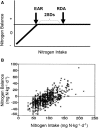Optimizing Protein Intake in Adults: Interpretation and Application of the Recommended Dietary Allowance Compared with the Acceptable Macronutrient Distribution Range
- PMID: 28298271
- PMCID: PMC5347101
- DOI: 10.3945/an.116.013821
Optimizing Protein Intake in Adults: Interpretation and Application of the Recommended Dietary Allowance Compared with the Acceptable Macronutrient Distribution Range
Abstract
The adult RDA is defined as the average daily level of intake sufficient to meet the nutrient requirements of nearly all healthy people. The RDA for protein for adults ≥18 y of age (0.8 g/kg) has been essentially unchanged for >70 y. In practice, the RDA for protein was derived to estimate the minimum amount of protein that must be eaten to avoid a loss of body nitrogen. The Acceptable Macronutrient Distribution Range (AMDR) (10-35% of calories as protein) was developed to express dietary recommendations in the context of a complete diet. It is noteworthy that the lowest level of protein intake reflected in the AMDR is higher than that of the RDA. Furthermore, recent studies, particularly in older individuals, suggest specific health benefits at levels of protein intake that significantly exceed the RDA. Translation of protein intake recommendations for the general adult population into dietary guidance for individuals requires an understanding of the derivation and intended use of both the protein RDA and AMDR. The following discussion will describe limitations to the derivation and practical application of the RDA compared with the use of the AMDR to help maximize health benefits associated with higher protein intake by using flexible calories inherent in different dietary patterns.
Keywords: AMDR; RDA; dietary pattern; nitrogen balance; protein.
© 2017 American Society for Nutrition.
Conflict of interest statement
Author disclosures: RR Wolfe has received research grants and/or honoraria for talks or consulting from The Beef Checkoff, Abbott Nutrition, Pronutria, and PepsiCo; AM Cifelli is employed by the National Cattlemen’s Beef Association; and G Kostas is a nutrition consultant, public speaker, media spokesperson, author, and registered dietitian. I-Y Kim, no conflicts of interest.
Figures


Similar articles
-
Effective translation of current dietary guidance: understanding and communicating the concepts of minimal and optimal levels of dietary protein.Am J Clin Nutr. 2015 Jun;101(6):1353S-1358S. doi: 10.3945/ajcn.114.084095. Epub 2015 Apr 29. Am J Clin Nutr. 2015. PMID: 25926508
-
Protein intake trends and conformity with the Dietary Reference Intakes in the United States: analysis of the National Health and Nutrition Examination Survey, 2001-2014.Am J Clin Nutr. 2018 Aug 1;108(2):405-413. doi: 10.1093/ajcn/nqy088. Am J Clin Nutr. 2018. PMID: 29931213
-
Dietary protein for athletes: from requirements to metabolic advantage.Appl Physiol Nutr Metab. 2006 Dec;31(6):647-54. doi: 10.1139/h06-035. Appl Physiol Nutr Metab. 2006. PMID: 17213878 Review.
-
Optimizing Adult Protein Intake During Catabolic Health Conditions.Adv Nutr. 2020 Jul 1;11(4):S1058-S1069. doi: 10.1093/advances/nmaa047. Adv Nutr. 2020. PMID: 32666115 Free PMC article. Review.
-
The effects of dietary protein intake on appendicular lean mass and muscle function in elderly men: a 10-wk randomized controlled trial.Am J Clin Nutr. 2017 Dec;106(6):1375-1383. doi: 10.3945/ajcn.117.160325. Epub 2017 Nov 1. Am J Clin Nutr. 2017. PMID: 29092886 Clinical Trial.
Cited by
-
The health effects of soy: A reference guide for health professionals.Front Nutr. 2022 Aug 11;9:970364. doi: 10.3389/fnut.2022.970364. eCollection 2022. Front Nutr. 2022. PMID: 36034914 Free PMC article. Review.
-
An Evaluation of the Nutritional Value and Physical Properties of Blenderised Enteral Nutrition Formula: A Systematic Review and Meta-Analysis.Nutrients. 2020 Jun 20;12(6):1840. doi: 10.3390/nu12061840. Nutrients. 2020. PMID: 32575695 Free PMC article.
-
Congregate Meals: Opportunities to Help Vulnerable Older Adults Achieve Diet and Physical Activity Recommendations.J Frailty Aging. 2018;7(3):182-186. doi: 10.14283/jfa.2018.21. J Frailty Aging. 2018. PMID: 30095149 Free PMC article.
-
Maximizing the intersection of human health and the health of the environment with regard to the amount and type of protein produced and consumed in the United States.Nutr Rev. 2019 Apr 1;77(4):197-215. doi: 10.1093/nutrit/nuy073. Nutr Rev. 2019. PMID: 30726996 Free PMC article. Review.
-
Nutrition management of PKU with pegvaliase therapy: update of the web-based PKU nutrition management guideline recommendations.Orphanet J Rare Dis. 2023 Jun 22;18(1):155. doi: 10.1186/s13023-023-02751-0. Orphanet J Rare Dis. 2023. PMID: 37349772 Free PMC article.
References
-
- Institute of Medicine of the National Academies. Dietary Reference Intakes for energy, carbohydrates, fiber, fat, protein and amino acids (macronutrients). Washington (DC): The National Academies Press; 2002/2005.
-
- U.S. Department of Health and Human Services and U.S. Department of Agriculture. 2015–2020 dietary guidelines for Americans [Internet]. 8th ed. [cited 2016 Feb 9]. Available from: http://health.gov/dietaryguidelines/2015/guidelines/.
-
- MyPlate Daily Checklist [Internet]. [cited 2016 Jan 26]. Available from: http://www.choosemyplate.gov/MyPlate-Daily-Checklist.
-
- FAO/WHO [Internet]. [cited 2016 Jan 26]. Protein quality evaluation: report of the joint FAO/WHO expert consultation, FAO Food and Nutrition 1999; paper 51. Rome (Italy); 1991.
Publication types
MeSH terms
Substances
LinkOut - more resources
Full Text Sources
Other Literature Sources
Medical

